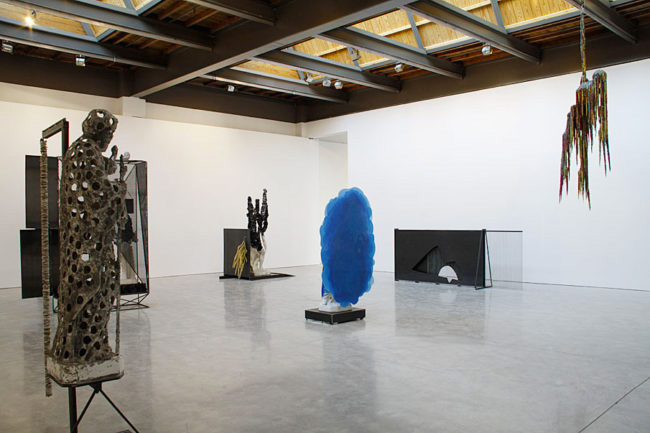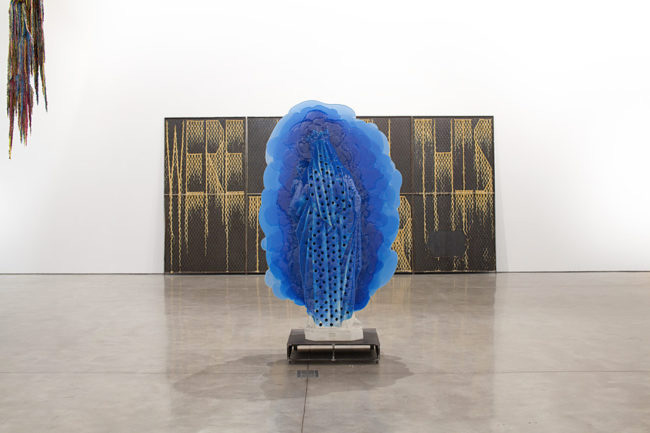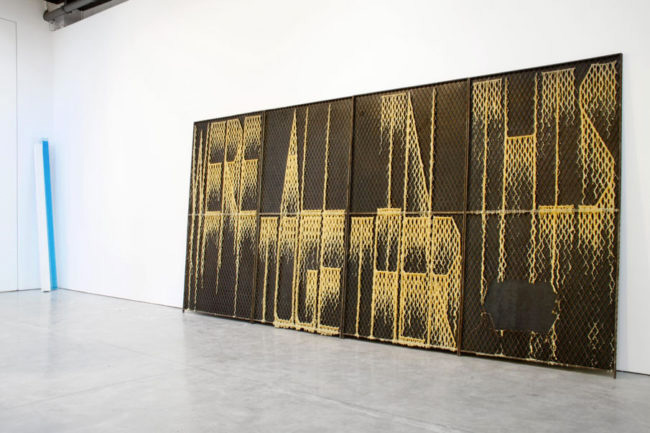
- Source: ART IN AMERICA
- Author: BRIENNE WALSH
- Date: DECEMBER 08, 2011
- Format: DIGITAL
Faux-Finished to the Core:
Q+A With Nick Van Woert

Breaking and Entering, exhibition view.
Nick Van Woert’s cavernous studio in Greenpoint, Brooklyn, is filled with all manner of good, clean fun, including a foosball table and a work surface that converts to a ping pong table. Walking through the studio, the tone becomes serious, littered as it is not just with wooden statues of religious figures but a cage modeled after a solitary confinement cell in a Supermax prison and the personal belongings of Ted Kaczynski, which he bought at an auction and has spread neatly on the floor like finds in an archeological dig. With such objects he explores the transcendentalism of Henry David Thoreau, the anti-industrial guerilla tactics of the Luddites and the homemade bombing techniques of the Monkey Wrench Gang.
Van Woert discussed his recent shows “Breaking and Entering” at Yvon Lambert in New York, which included works such as classical statues transformed by fiberglass drips, and “Anatomy” at Yvon Lambert in Paris that was a stark black-and-white presentation of minimalist sculpture, many of them filled with bright primary colors. In March 2012, he’ll open a show at Grimm Gallery in Amsterdam.
BRIENNE WALSH Much of your work is created using a pre-existing sculpture as a foundation. Do you see them as armatures for a certain set of ideas about representing the human form, or the idea of sculpture in general?
NICK VAN WOERT I’m interested in the evolution of materials in architecture and art, in terms of how the body is represented. If you look at it historically, you see a move from the monolithic materials of classical figures to the fake hollow plaster casts that we use to reproduce them today. It says something about how these days we’re interested in preserving the past, but only visually. There is no material continuity. The materials are more or less insignificant.
WALSH So you think that materials should come before visual representation?
VAN WOERT For me, art is a material language first, and I think that we should look at the world with the same approach. What if we saw things, and thought about them in terms of how they were made rather than what they looked like?
WALSH Many of the works in “Breaking and Entering” use plaster casts of classical sculptures as a starting point. Do you make them yourself or appropriate them from somewhere else?
VAN WOERT All of the statues are bought. For me, it doesn’t make sense to make them myself. It makes sense to use them as found objects. I get them at a place that makes castings and molds and rents them to companies like Martha Stewart for photo shoots. For me, they are masquerading as sculpture because they are objects, but they’re not participating in an artistic dialogue about materials and forms of representation. They’re on the commercial side of the art highway, trying to get a ride, and I pick them up.
WALSH Why do you use these sculptures in particular?
VAN WOERT Because they highlight the evolution of the monolith to a chemical cocktail of materials. We’re not running out of stone or wood. We can make things like that easily, but we prefer things out of materials like polyurethane, which is the high fructose corn syrup of the built environment. It’s in everything from waterproof jackets to mattresses. It can be rigid or flexible. It’s cheapish. It’s quick to use, but it doesn’t last.
WALSH When you transform these pieces with fiberglass and polyurethane, how much do you let the materials take their own form?
VAN WOERT First, I place the plaster cast on the ground and pour the plastic over it. The idea is that the shape of the sculpture determines the shape of the blob, but I get super picky and try to control it as much as I can. I’m a proportion freak. But to lose control is fun, because you make something that is more beautiful than you could ever create yourself, like icicles on an overhang, or the holes fire makes when it burns through a material. There’s that feeling that certain things are exactly how they should be. I wish my work could be more like that.

Nick Van Woert, Mary Mary, 2011, fiberglass statue, polyurethane plastice, steel plinth with wheels, 46 x 80 x 24 in.
WALSH In your studio, you have a lot of Ted Kaczynski ephemera, including his decaying baseball hats and his hatchets. Where does your fascination with him lie?
VAN WOERT With his relationship to Henry David Thoreau. Kaczynski lived outside the comforts of modern life. I see that as form of revolt. Both Thoreau and Kaczynski wanted to get back to basics and live without the comforts that technology brings. I want to explore that more in my own work.
WALSH Do you yourself live differently, outside the comforts of modern life?
VAN WOERT Whenever I’m asked this, I think about an interview I once read with the band Slayer. They wrote all these songs about serial killers and had some crazy fans, but they lived lives like anyone else. They have families. They don’t kill people. I live a pretty ordinary life.
WALSH So where does the interest in isolating yourself from modernity stem from?
VAN WOERT A lot of it is rooted in how I grew up in Reno, Nevada, which is just super rich geographically. The urban environment there is really strange. There’s this gambling lifestyle that promotes the idea that you can be a flashy person, but you will probably never get there. And the advertising and architecture are almost indistinguishable, faux-finished to the core. At the same time, you have this really dry, raw nature that surrounds the city, and could take it over at any time. I’m not interested in mimicking the fiction of the architecture there. We have enough fictional stuff in the world now. Reality is way more frightening.
WALSH In the show at Yvon Lambert, you included a number of large-scale architectural drafting templates that seem to fit into your fascination with people who live outside of society. How do these works fit into the larger theme of rebelling against standardized life?
VAN WOERT Well, in real life the templates are used for drafting standardized forms in every part of a construction. They create standardized forms filled with standardized furniture. And what kind of life does that yield? A standardized life. In that space, do things become really sterile, or ultracreative? In my mind, you can’t do anything but rebel against it.
WALSH In some of your more recent work, which includes Plexiglas boxes filled with everyday materials such as concrete, bleach, Lysol and detergent, you explore the idea that the things we buy in grocery stores might appear friendly on the surface but can be used towards darker ends. Is there a sense that you’re adopting orphan materials?
VAN WOERT All of them accrue meaning outside, so I borrow that meaning. It’s not arbitrary. Some of the things I’ve made, and some are found. The concrete, clay, Coca-Cola, lead, dishwasher tablets, stones, Sheetrock all come from Home Depot. For the colorful ones, I go to the grocery store. I feel like a painter, and that’s my palette. It’s like orange soda, ceiling tiles, mouthwash, charcoal and hair gel don’t naturally go together, but when they’re combined, they look great! The colors at surface level look so safe, and so fun.
WALSH Some of the other materials you use, such as the chlorine and hair gel, were used by the fictional fringe group the Monkey Wrench Gang to construct homemade bombs, which they used to blow up billboards.
VAN WOERT I’d been making stuff about billboards for years, and then I read A Field Guide to Monkeywrenching, a practical handbook to guerilla tactics for protecting the natural world based on The Monkey Wrench Gang, a novel by Edward Abbey about environmental terrorists in the 1960s and ’70s. In the first chapter of the book, the character Foreman talks about finding a billboard and burning it down with an envelope of chlorine and hair gel. I liked it, because chlorine is about the leisure lifestyle of poolside lounging and hair gel is about looking fresh, but hiding behind them is this crazy darkness.
I guess I’m interested in their efforts to live outside their comfort zones. That’s a form of creativity. It’s easy to do what everyone else is doing.

Nick Van Woert, We're All In This Together, 2011, found steel, steel, polyurethane adhesive, plexiglass, hair gel, chlorine. Steel panels are 192 x 97 x 1 in. Plexiglass boxes are 5 x 5 x 96 in.

